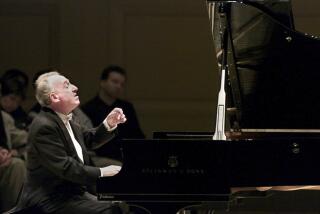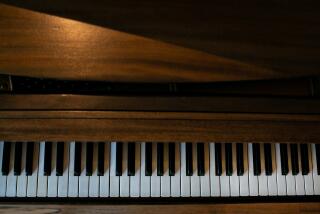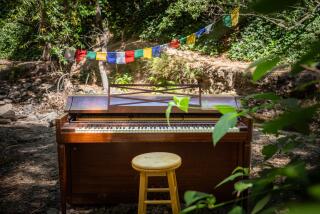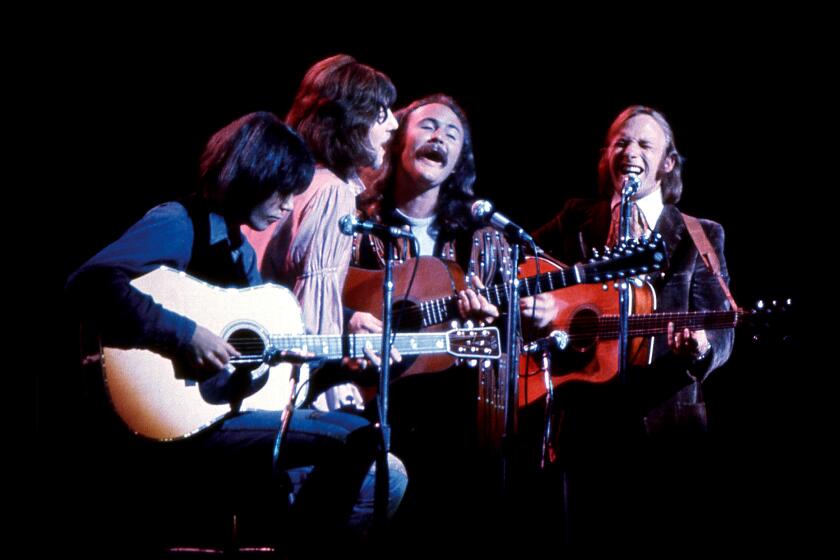Grands’ Stand
- Share via
On a winter day in the early 1970s, a sales rep for a big American piano company was visiting one of the stores he regularly called on.
He stood among three or four grand pianos and ran his hand along the satiny black cabinet of one of them, as if stroking the neck of a horse.
“These babies are so pretty,” said the rep. “Too bad they’re on the way out.”
A lot of people in the business were thinking similar thoughts at the time. The widespread expectation was that electronic organs, with their cha-cha rhythms and cinchy one-finger chords, were the wave of the future. The traditional acoustic-piano business, by then primarily aimed at families with school-age children, would be increasingly confined to smaller vertical (or upright) pianos, known as spinets and consoles. The large and costly grands, meanwhile, would fade as a home consumer item.
More than 20 years later, the verdict is in on these predictions: Wrong on all counts. Small vertical pianos, especially the compact but musically compromised spinet, now constitute a negligible portion of the piano business.
But grand pianos--the imposing, wing-shaped beauties that had been deemed unsuitable for modern homes and modern habits--are flourishing.
The resurgence is a monument to many things: rising prosperity, a restless quest among affluent baby boomers for life’s finer things, and, perhaps more poetically, a rejection of the ephemeral in favor of the timeless.
“Not only did the industry fail to predict the current boom in grand pianos, it still doesn’t entirely understand why it’s happening,” says Paul Murphy, president of M. Steinert & Sons, one of Boston’s oldest and biggest piano dealers.
For generations, pianos were purchased overwhelmingly by parents, as a vehicle of betterment for their children. Piano lessons were a rite that millions of middle-class kids could routinely expect to partake of (or endure), and the piano business was all too happy to accommodate the tradition.
“Many more of our customers now buy a piano for themselves,” Murphy says. “They are often middle-aged people who may or may not have played when they were younger, and are not necessarily serious players, but they are interested in both the recreation and discipline of playing.”
The instrument selected for children was often a small, inexpensive vertical, in part because it could be jettisoned with a minimal sense of loss if the day came when young Tommy or Susie was finally allowed to quit.
As so often in life, the best comes at a price. In round numbers, the least expensive viable new grand piano today costs close to $10,000, with the finest concert grands extending well into six figures. Although pianos made in South Korea, eastern Europe, Russia and even China are now finding their way into the United States, and helping to bring down the average cost of grands, the venerable, and pricey, trio of Steinway, Baldwin and Yamaha account for more than half of all U.S. grand sales.
“The people buying these pianos are all doing well, and they don’t feel that spending $15,000 or $20,000 is unreasonable,” says Larry Fine, a piano technician and historian, and author of “The Piano Book” (Brookside Press, 1987), a brand-by-brand guide to piano buying.
The term “grand piano” applies to any horizontally strung, wing-shaped piano, from a full-size concert model (generally 9 feet long or thereabouts) down to models of 5 feet and even less, known colloquially as “baby” grands.
If many grand buyers are making their purchases with an eye toward actually sitting down to play, there are still many who acquire the instruments for symbolic or decorative reasons. The piano business calls these trophy buyers, and they have been around as long as the instrument. Paradoxically, while many grands of the 19th and early 20th centuries were breathtakingly ornate, with turned legs and complex scrollwork and sometimes even sporting hand-painted scenes, modern grands tend to offer little in the way of stylistic differentiation.
In the interest of perspective, the new-piano business as a whole is decent if not robust.
Between 90,000 and 100,000 new pianos were sold in the United States in 1995, the last full year for which numbers are available. That’s about where the number has been for the past five years or so, but it’s sharply down from the industry’s postwar high-water mark of about 280,000 units, achieved in 1978.
Tellingly, grands accounted for just 7% of the 1978 figure, as compared to more than 30% in 1995.
But the new-instrument figures tell only a portion of the story.
“Our research tells us that there are at least 17 million used pianos in use in this country,” says Terry Lewis, a vice president at Yamaha. “Of those, we calculate that between 700,000 and 900,000 change hands each year. This is a huge issue for manufacturers. An average piano lasts more than 50 years, or longer in the case of good-quality grands.”
More to Read
The biggest entertainment stories
Get our big stories about Hollywood, film, television, music, arts, culture and more right in your inbox as soon as they publish.
You may occasionally receive promotional content from the Los Angeles Times.










